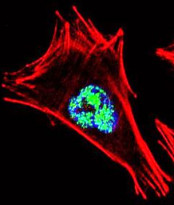ARG42020
anti-Prox 1 antibody
anti-Prox 1 antibody for ICC/IF,Western blot and Human
Cell Biology and Cellular Response antibody; Gene Regulation antibody; Neuroscience antibody; Hippocampal Neurogenesis Marker antibody; Intermediate Progenitor Cells Marker antibody
Overview
| Product Description | Rabbit Polyclonal antibody recognizes Prox 1 |
|---|---|
| Tested Reactivity | Hu |
| Tested Application | ICC/IF, WB |
| Host | Rabbit |
| Clonality | Polyclonal |
| Isotype | IgG |
| Target Name | Prox 1 |
| Antigen Species | Human |
| Immunogen | KLH-conjugated synthetic peptide between aa. 492-522 of Human Prox 1. |
| Conjugation | Un-conjugated |
| Alternate Names | Prospero homeobox protein 1; Homeobox prospero-like protein PROX1; PROX-1 |
Application Instructions
| Application Suggestion |
|
||||||
|---|---|---|---|---|---|---|---|
| Application Note | * The dilutions indicate recommended starting dilutions and the optimal dilutions or concentrations should be determined by the scientist. | ||||||
| Positive Control | HepG2 | ||||||
| Observed Size | ~ 90 kDa |
Properties
| Form | Liquid |
|---|---|
| Purification | Saturated ammonium sulfate precipitation followed by dialysis against PBS. |
| Buffer | PBS and 0.09% (W/V) Sodium azide. |
| Preservative | 0.09% (W/V) Sodium azide |
| Storage Instruction | For continuous use, store undiluted antibody at 2-8°C for up to a week. For long-term storage, aliquot and store at -20°C or below. Storage in frost free freezers is not recommended. Avoid repeated freeze/thaw cycles. Suggest spin the vial prior to opening. The antibody solution should be gently mixed before use. |
| Note | For laboratory research only, not for drug, diagnostic or other use. |
Bioinformation
| Database Links | |
|---|---|
| Gene Symbol | PROX1 |
| Gene Full Name | prospero homeobox 1 |
| Background | The protein encoded by this gene is a member of the homeobox transcription factor family. Members of this family contain a homeobox domain that consists of a 60-amino acid helix-turn-helix structure that binds DNA and RNA. The protein encoded by this gene is conserved across vertebrates and may play an essential role during development. Altered levels of this protein have been reported in cancers of different organs, such as colon, brain, blood, breast, pancreas, liver and esophagus. Alternative splicing results in multiple transcript variants. [provided by RefSeq, Jul 2012] |
| Function | Transcription factor involved in developmental processes such as cell fate determination, gene transcriptional regulation and progenitor cell regulation in a number of organs. Plays a critical role in embryonic development and functions as a key regulatory protein in neurogenesis and the development of the heart, eye lens, liver, pancreas and the lymphatic system. Involved in the regulation of the circadian rhythm. Represses: transcription of the retinoid-related orphan receptor RORG, transcriptional activator activity of RORA and RORG and the expression of RORA/G-target genes including core clock components: ARNTL/BMAL1, NPAS2 and CRY1 and metabolic genes: AVPR1A and ELOVL3. [UniProt] |
| Cellular Localization | Nucleus. Note=RORG promotes its nuclear localization. [UniProt] |
| Research Area | Cell Biology and Cellular Response antibody; Gene Regulation antibody; Neuroscience antibody; Hippocampal Neurogenesis Marker antibody; Intermediate Progenitor Cells Marker antibody |
| Calculated MW | 83 kDa |
Images (2) Click the Picture to Zoom In
-
ARG42020 anti-Prox 1 antibody ICC/IF image
Immunofluorescence: A2058 cells were fixed with 4% PFA for 20 min, permeabilized with 0.1% Triton X-100 for 10 min, then stained with ARG42020 anti-Prox 1 antibody (green) at 1:25 dilution for 1 hour at 37°C. Cytoplasmic actin was counterstained with Alexa Fluor® 555 (red) conjugated Phalloidin. DAPI (blue) for nuclear staining.
-
ARG42020 anti-Prox 1 antibody WB image
Western blot: 20 µg of HepG2 whole cell lysate stained with ARG42020 anti-Prox 1 antibody at 1:2000 dilution.







